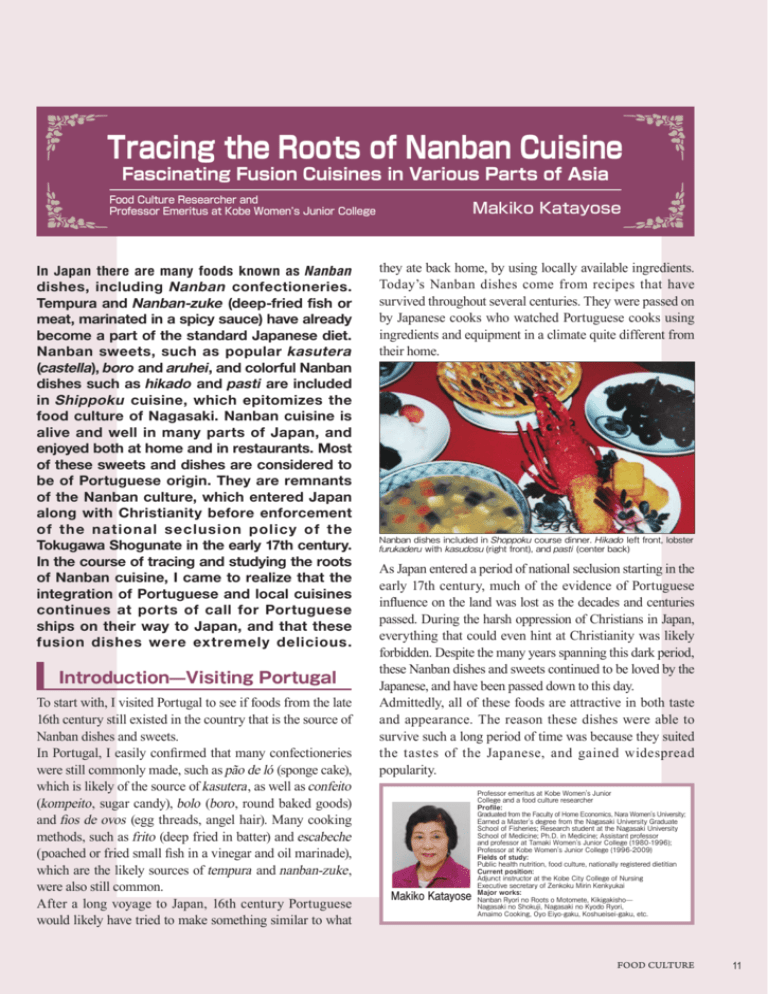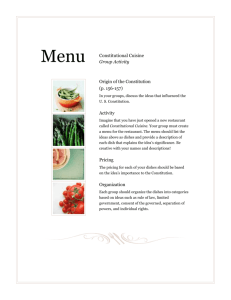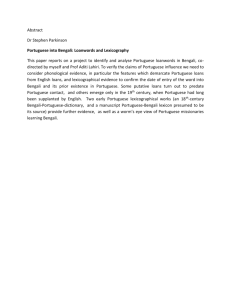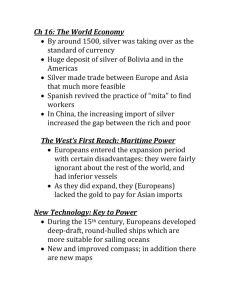Tracing the Roots of Nanban Cuisine Fascinating Fusion Cuisines in
advertisement

Tracing the Roots of Nanban Cuisine Fascinating Fusion Cuisines in Various Parts of Asia Food Culture Researcher and Professor Emeritus at Kobe Women’s Junior College In Japan there are many foods known as Nanban dishes, including Nanban confectioneries. Tempura and Nanban-zuke (deep-fried fish or meat, marinated in a spicy sauce) have already become a part of the standard Japanese diet. Nanban sweets, such as popular kasutera (castella ), boro and aruhei , and colorful Nanban dishes such as hikado and pasti are included in Shippoku cuisine, which epitomizes the food culture of Nagasaki. Nanban cuisine is alive and well in many parts of Japan, and enjoyed both at home and in restaurants. Most of these sweets and dishes are considered to be of Portuguese origin. They are remnants of the Nanban culture, which entered Japan along with Christianity before enforcement of the national seclusion policy of the Tokugawa Shogunate in the early 17th century. In the course of tracing and studying the roots of Nanban cuisine, I came to realize that the integration of Portuguese and local cuisines continues at ports of call for Portuguese ships on their way to Japan, and that these fusion dishes were extremely delicious. Introduction—Visiting Portugal To start with, I visited Portugal to see if foods from the late 16th century still existed in the country that is the source of Nanban dishes and sweets. In Portugal, I easily confirmed that many confectioneries were still commonly made, such as pão de ló (sponge cake), which is likely of the source of kasutera , as well as confeito (kompeito , sugar candy), bolo (boro , round baked goods) and fios de ovos (egg threads, angel hair). Many cooking methods, such as frito (deep fried in batter) and escabeche (poached or fried small fish in a vinegar and oil marinade), which are the likely sources of tempura and nanban-zuke , were also still common. After a long voyage to Japan, 16th century Portuguese would likely have tried to make something similar to what Makiko Katayose they ate back home, by using locally available ingredients. Today’s Nanban dishes come from recipes that have survived throughout several centuries. They were passed on by Japanese cooks who watched Portuguese cooks using ingredients and equipment in a climate quite different from their home. Nanban dishes included in Shoppoku course dinner. Hikado left front, lobster furukaderu with kasudosu (right front), and pasti (center back) As Japan entered a period of national seclusion starting in the early 17th century, much of the evidence of Portuguese influence on the land was lost as the decades and centuries passed. During the harsh oppression of Christians in Japan, everything that could even hint at Christianity was likely forbidden. Despite the many years spanning this dark period, these Nanban dishes and sweets continued to be loved by the Japanese, and have been passed down to this day. Admittedly, all of these foods are attractive in both taste and appearance. The reason these dishes were able to survive such a long period of time was because they suited the tastes of the Japanese, and gained widespread popularity. Makiko Katayose Professor emeritus at Kobe Women's Junior College and a food culture researcher Profile: Graduated from the Faculty of Home Economics, Nara Women's University; Earned a Master's degree from the Nagasaki University Graduate School of Fisheries; Research student at the Nagasaki University School of Medicine; Ph.D. in Medicine; Assistant professor and professor at Tamaki Women's Junior College (1980-1996); Professor at Kobe Women's Junior College (1996-2009) Fields of study: Public health nutrition, food culture, nationally registered dietitian Current position: Adjunct instructor at the Kobe City College of Nursing Executive secretary of Zenkoku Mirin Kenkyukai Major works: Nanban Ryori no Roots o Motomete, Kikigakisho— Nagasaki no Shokuji, Nagasaki no Kyodo Ryori, Amaimo Cooking, Oyo Eiyo-gaku, Koshueisei-gaku, etc. FOOD CULTURE 11 Pão de ló and fios de ovos , which are the likely sources of kasutera and keiran somen . Fritos , deep-fried foods with a salted batter, are a common home-cooked dish that resembles Nagasaki tempura. They are made with common ingredients, including whitefish , sweet potatoes, pumpkin, eggplant and green beans. A local frito shop in town. The cooking method of dipping fish in batter and frying it in oil is identical to Japan’s tempura. Some say the term “tempura” is derived from temperar. The Route from Portugal to Japan Cabo da Roca (Cape Roca) marks the westernmost point of the European continent. There is a monument standing on Cabo da Roca with inscription of the words of Luís de Camões, Portugal’s most renowned poet, reading “Onde a terra acaba e o mar começa.” (Where the earth ends and the sea begins.) Over the vast ocean that expands beyond the horizon lies the Land of Gold, Zipangu (Japan). People during the Age of Exploration desperately longed to reach this destination. While I was standing on the cape, images of great explorers, men of ambition, and monks of days long past crossed my mind. They would have set off across the vast ocean for an expedition, each with reasons of his own. Some set out for a journey of exploration and adventure, some dreamed of conquering a foreign land, getting rich and earning honors, and some served the cause of 12 FOOD CULTURE spreading Christianity to an unknown world and converting heathens to the Christian faith. Under the leadership of Prince Henry the Navigator (1394– 1460) who strongly advocated expeditionary voyages, Portugal proceeded with exploring, conquering and colonizing coastal areas of Africa and nearby islands. Later, in 1498, Vasco da Gama reached India via Cape Town. In 1510, Afonso de Albuquerque occupied Goa, India, and built a base there. Goa thrived, and grew to be a large city known as Golden Goa, with a population of 200,000 to 300,000 at its prime in the late 16th century. After Goa, the Portuguese established bases at Malacca and then at Macau. Between these advancements, Portuguese with firearms drifted ashore on the island of Tanegashima in 1543. Subsequently, Portuguese ships arrived at other coastlines in Kyushu. Eventually, as regular fleets were able to reach Japan, the following route (shown on the map) was established: Lisbon (Portugal) – Goa (India) – Malacca (Malaysia) – Macau (China) – Nagasaki (Japan) At each of these ports of call, unique new food cultures may have been created, with Portuguese food culture brought in and blended with local foodstuffs and traditional cookery methods. There are roughly 60 Nanban folding screens known to be in existence that feature the arrival of Nanban people (Europeans, mainly Portuguese) at Japanese ports. These screen paintings depict non-Caucasian people appearing to be Africans, Arabians, Indians and other various Asian races along with the white Europeans. They were probably brought on board at ports en route to Japan as servants, sailors or cooks. Looking at these paintings as reminders that Portuguese ships stopped at several ports on their way to Japan, I realized that Nanban dishes in Japan could be an amalgamation of many different food cultures, and not just strictly a result of Portuguese food influence. Main route of Nanban ships from Portugal to Nagasaki, Japan, and their ports-of-call Fusion Cuisine—An Integration of Western and Oriental Food Cultures Four centuries have passed since Portuguese ships first came to Japan. Yet, some of the ports en route were maintained under Portuguese control until recently, and food culture was continuously brought in from Portugal. I was lucky enough to live in Nagasaki City for 26 years, from 1970 until 1996. In the course of studying the food culture of Nagasaki, which had maintained exchange with the outside world even during the period of national seclusion as the only point of foreign trade, I rediscovered the charm of Nanban cuisine in Japan as a hybrid of Japanese, Chinese and Western cuisines. I theorized that Macau, Malacca, Goa and East Timor might have food cultures similar to Japan’s Nanban cuisine. To follow up on this, I visited these places as often as time permitted, and discovered a number of wonderful fusion cuisines born through a blend of Western and Oriental food cultures. (1) Goa Region, India—Integration with Indian Cuisine Goa (presently, Panaji, or Panjim in English) in India still vividly retains its Portuguese influence in several aspects. Roughly half of the residents are said to be either the descendants of those who became Roman Catholics when Goa was a Portuguese colony or of mixed Indian and Portuguese blood. In the town of Panaji, there are Portuguese-style buildings and churches, and bakeries specializing in Portuguese-style fresh bread. At Panaji I interviewed a scholar who studied Portuguese-influenced Goa foods, and was fortunate enough to see her prepare some of these dishes in person. In India, the mixture of various spices called masala (in Hindi) is the basis of many dishes, and every household has a millstone used to prepare masala in the kitchen. Most of the dishes that originated in Portugal were also flavored with masala, and were very spicy. Cavala recheiado (mackerel stuffed with masala) is one such dish. I also European-style townscape remaining in Goa noticed some differences in seasonings used in Goa’s chorizo and Por t ug uese chouriço . T he Goa ve r sio n i s a mu ch spicier sausage than the Galinha a cafrial eference (stir-fried spicy latter, with the use of chicken) in Goa. A dish brought in from Africa by Portuguese ships. garlic, pepper, red chili, cumin seed, clove, turmeric, cinnamon, ginger, vinegar, palm wine, and more. Another difference in flavor seemed to come from the ingredients used. When foreign cuisines are adopted, it is common for locally available foodstuffs to be used in place of the original ingredients, which may be hard to Ms. Maria Rodriguez preparing cavala c o m e b y. I n G o a , recheiado (mackerel stuffed with masala) coconut milk is often used instead of cow’s milk, and locally produced cashew nuts are used to replace almonds. Many of the dishes use local ingredients and are named in a mixture of Portuguese and English. (2) Malacca—Unique Kristang Cuisine In Malacca in Malaysia, I was able to experience Kristang cuisine, which was born from the influence of Portuguese cuisine, and I met one of its inheritors, Ms. C. J. Marbeck. Kristang cuisine has been passed down by Portuguese Malaccans who call themselves Kristang (descendants of 16th century mixed Portuguese and Malaccan), are Roman Catholics, and speak a unique creole language, also called Kristang . In Malacca, Nyonya Baba cuisine is a famous blend of Malay and China cuisines. Kristang cuisine is the addition of Portuguese cuisine to Nyonya Baba cuisine. Portuguese influence is evident in both food names and Church in the central district of Malacca FOOD CULTURE 13 Devil curry in Malacca. Ingredients and seasonings include chicken, potatoes, onions, ginger, shallots, candlenuts, turmeric, chili pepper, tamarind and soy sauce. Galinhia pai(chicken pie)in Malacca. Stewed chicken and vegetables, including the broth, are put into a bowl and baked in an oven after the top has been covered with a piecrust. Very much like pasti in Nagasaki. Portuguese-style sweets, egg tarts, and pan (buns) C hic h a rru soy lim a ng (hardtails in lime and soy sauce) in Malacca. Identical to nanban-zuke in Japan cookery, and local foodstuffs and cooking methods are tactfully incorporated. Ms. Marbeck told me that the cuisine features a complex flavor achieved by the delicate balance of spicy, pungent, sweet and sour tastes. In addition to such excellent dishes as debal (devil curry), semur (beef stew), pang susi (sweet potato bread with minced meat filling), and kuih tat (pineapple tart), there were dishes similar to Nanban dishes in Japan, such as chicharru soy limang (hardtails in lime and soy sauce) and galinhia pai (chicken pie). I had the strong impression that these two dishes could be the origins of the nanban-zuke and pasti introduced to Japan. (3) Macau—Integration with Chinese Cuisine At Macau, the former crossroads of Eastern and Western civilizations, Portuguese and Chinese food cultures joined together. With the further additions of foods and spices brought in from Africa, India, Southeast Asia and Brazil, a complex fusion cuisine was born. People with some Portuguese ancestry are called Macanese. Portuguese-style Macau cuisine has been passed down through the generations in their homes. In the city of Macau, there are restaurants that offer Macau cuisine in a homey atmosphere, and the menu of the day is written in both Portuguese and Chinese. Dishes brought in by housewives, such as Portuguese chicken, curried chicken and minchi, have the relaxed and comforting taste of home cooking. Portuguese-style restaurants serve African chicken and curried crab, along with Portuguese dishes. While at 14 FOOD CULTURE Curried crab in Macau Chinese restaurants in Macau, I enjoyed fusion dishes such as duck with blood sauce and the stew dish called tacho . At a sweet shop near the Chapel of St. Francis Xavier on Coloane Island, Portuguese-style buns and Portuguese egg tarts seemed to be very popular among the locals. (4) East Timor—Delicious Foods at Portugal Restaurants I visited East Timor (then under Indonesian control) in the summer of 1997, fully expecting the Portuguese influence on local food culture to be prominent, as they spent nearly 400 years as a Portuguese colony. Within the capital city, Dili, there were several Portuguese restaurants where I enjoyed colorful and delicious Portuguese dishes prepared with local ingredients. Like other former ports-of-call for Portuguese ships, these dishes were spicier than similar dishes in Portugal. Two years after my visit, Dili became a war-torn city, and I was worried about what happened to friends I had made during my visit. Iscas com batata frita (liver with fried potatoes) served at a Portuguese restaurant in East Timor According to an acquaintance of mine, some of the Portuguese restaurants have restarted their business since winning independence in May 2002. Conclusion—The Charm of Fusion Cuisines I was able to confirm that in each place influenced by Portugal a new fusion cuisine was created, as with Nanban cuisine in Japan. Finely adopting and blending the goodness of East and West, they are simple and savory, and deeply flavorful. References Nanban Ryori no Roots o Motomete , Makiko Katayose, Heibonsha Limited, 1999








